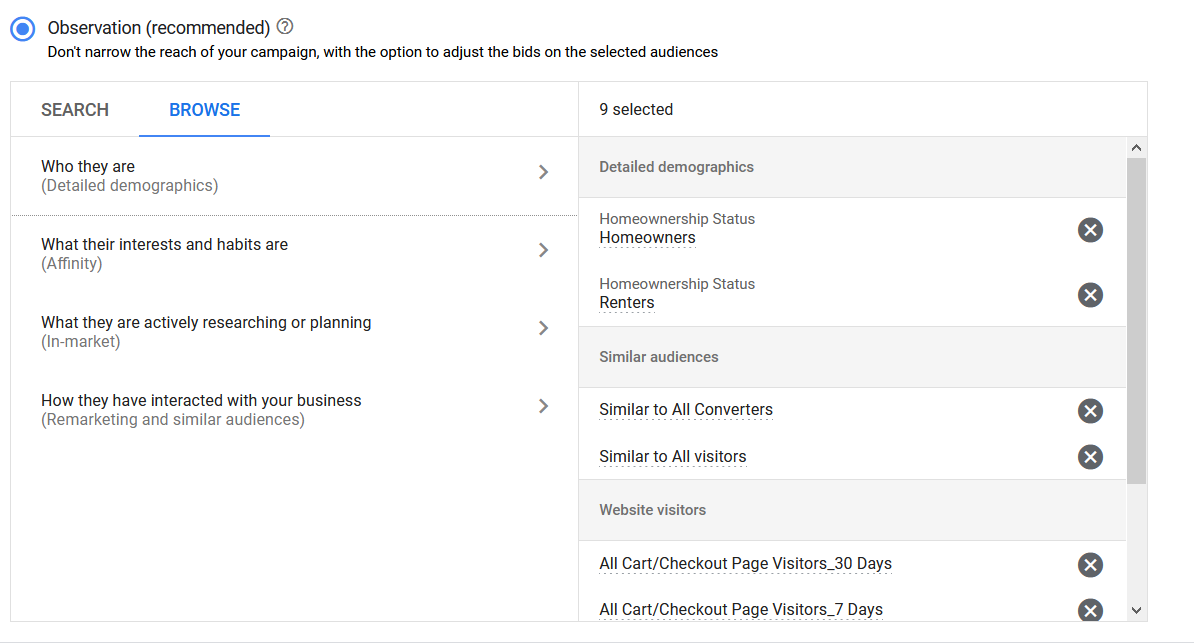
Audiences, layered over other means of targeting in PPC platforms like Google Ads, can provide us with further means of refinement in our marketing campaigns. If one delves into all of the available types of audiences, the prospects can seem tantalizing.
For years, the main types of audiences used tended to be for remarketing. In many cases, that hasn’t changed. Not only can you come up with different approaches to targeting past visitors to your website, cart abandoners, and the like, you can in some cases use your email list as an audience (Google calls this Customer Match).
In the interface lurks a veritable boutique of different audience definitions that allow you to go “shopping” for interesting audiences to work into your targeting. (Note: some of these work with the native Google Ads or Google Analytics tracking pixel, would be considered “first-party data,” and may have minimum audience size requirements. Others are available no matter what.)

Figure 1: Drill down into a multifaceted world of audience targeting delights.
Formally, these are broken down into four types:
- How they have interacted with your business (remarketing and similar audiences). Many marketers recognize this as the primary type of audience definition. “Similar” audiences actually haven’t interacted with your business, but they’re supposed to be statistically similar users and user sessions. Somehow, the digital, behavioral, and demographic “fingerprints” of your own site visitors or purchasers are compared with a vast audience of everybody else, and if they’re deemed close enough, those audience members are included in the Similar audience. In Facebook, this is called a Lookalike audience. Typical primary remarketing audiences could include whoever has visited a certain section of the website in the past 14 days, those who are past purchasers, etc. More complex audience definitions may be better off set up in Google Analytics and then imported into Google Ads.
- What their interests and habits are. For example, in the Home and Garden space, Google Ads offers a (rather diffuse) category called “Home Décor Enthusiasts.”
- What they are actively researching or planning (In-Market). You sell underwater cameras and they’re actively researching or planning to buy a “camera” or “outdoor gear”? Sounds pretty good, right? Some available audiences are quite granular, such as actively researching trips to highly specific locations such as “Israel,” or “Trips to Oklahoma City” (I kid you not).
- Who they are (Detailed Demographics). Examples include “Married” and “Works in the Hospitality Industry.”
Advertisers can add as many or as few audiences to campaigns as they like. Some advertisers stick strictly to keyword targeting, ad testing, and a few other refinement techniques, without ever adding a single audience.
What’s in an Audience?
How does Google know so much information about (anonymized – the advertiser only gets pools of data, never personal information) online behaviors? Well, you can probably appreciate how. Across dozens of core Google properties are several particularly “personal” experiences – Gmail, YouTube, etc. – where users are always or usually logged in, and where they either voluntarily or by implication give up certain demographic and behavioral details. Android and Chrome take advantage of tying users to an identity as well. The majority of websites in the world track users with Google Analytics. Google has a large Display Network and divisions like DoubleClick that have data on a large portion of user journeys across a huge swath of websites that show advertising to cookied users.
In other words, nothing is stopping Google from conjoining and cross-referencing user information from Gmail, YouTube, Google Search, Google Analytics, DoubleClick, and more, to understand (anonymized) individual user characteristics, demographics, and recent and sustained online behaviors.
This has led them to offer an array of audiences that may be of interest to advertisers. Some are getting more exotic or focused on economic behaviors: for example, Google now offers new quirky shopping-centric audience definitions such as Shopaholics and Black Friday Fanatics. From the above logic, it isn’t so hard to see how Google can achieve that while adhering to at least the legal letter of privacy legislation, if not its spirit.
4 Misconceptions About Audiences
Google is without a doubt a type of monopoly in online advertising and online user data collection. It’s so omniscient that it can ban/discourage tracking techniques such as device fingerprinting that it no longer needs to rely on. “Sneaky” tracking methods are what some of Google’s competitors are relegated to. Just when you think a rival publisher or platform can compete, Google cracks down on them. In my non-legal opinion, such measures are anti-competitive.
Advertisers, then, have access to a dazzling menu of potential audiences to help them in their targeting. And dazzled they often become, for many advertisers dive into the Audience deployment game harboring some serious misconceptions about how actionable or helpful these audiences are to marketing objectives. Let’s address a few of these.
1. Conceiving of Audiences as a way to reach out to “new people,” and conversely, experiencing FOMO when not adding Audiences to a campaign.
Because channels like Facebook, YouTube, and the Google Display Network are powered by audiences that are used not only for bid refinement, but also to enable targeting to reach new prospects cold, it’s easy to forget that the typical use of Audiences within a Google Ads campaign for Search does not give you access to swaths of “new people” you would otherwise be missing out on.
Hear me well: if you do some Googling on this subject, you’ll run across some very long-winded, vaguely technical-sounding articles enthusing about the use of audiences, “layering” audiences, and all the marvelous targeting you can access with them. These articles are mostly B.S. They seem to have inherited some sly Google packaging that (appropriately, at least) enthuses about the use of audiences in Display (or to be more accurate, the highly limiting Google Display Network). The gee-whiz power of the targeting is then assumed to be equally whiz-bang in a Search environment. It isn’t.
When Audience settings are set to Targeting at the campaign level, now you are targeting only the searchers who (a) typed in keywords which could result in your ad being eligible to show, and (b) were deemed to be within the Audience in question. If you defined only audiences who, say, visited your website in the last 30 days, your campaign is now remarketing only (not in a Display context where people are likely to run across your ad, but literally waiting for that small number of people to perform a search again, and bidding a bit more, perhaps, to reach them this time around). Fine if that’s what you wanted, but generally speaking, advertisers want to use Observation in order to deploy a hybrid approach – reaching all eligible searchers based on the keyword targeting chosen, and also refining bids on a subset of those.
2. Just throw a lot of audiences into the campaign so you get tons of data.
Really? Are you short on data? What do you attempt to accomplish? You probably wouldn’t add an excess of keywords, an excess of geo segments, an excess of ad versions, or an excess of actual products and services your business sells, so why just toss Audiences into campaigns willy-nilly? In any marketing exercise that will require coherent analysis, it’s fair to say it helps to have a hypothesis and a plan (or raison d’être) for anything you add to your Google Ads account.
3. Related to (2): there is a myth that you can confidently bid-adjust the audiences in response to performance data (for example, KPI’s like ROAS).
Unfortunately, this just isn’t the case. It comes down to weak documentation of how much attribution the audiences even receive in the Google Ads reporting, and how that attribution may or may not be organized.
What I would expect: if you’ve added twelve audiences to a campaign, and three of them (overlapping in some way) mostly, partially, or completely represent a user who made a purchase, then the fractional attribution assigned to these would faithfully represent those audience contributions to the sale, depending on the attribution model you’ve chosen. And the number would match whatever attribution is happening in other views (such as at the keyword level) across your campaigns. Well, that’s not how it works. And no one at Google or anywhere else seems terribly interested in documenting or explaining how it does work. So we’re left feeling around in the mist. As one industry colleague tweeted: “Pick your fog.” The takeaway is that you have to take this data with an outsized grain of salt. Some audiences seem to show us stronger performance from certain audiences – let’s say, one defined as “works for a very large company.” If so, we can make some headway in targeting.
4. Related to (3): So-called “In-Market” audiences bring home the bacon and fry it in a pan.
Sounds intuitive, right? Statistics profile this user as actively researching a car or toilet brush purchase, so bid up on those people and get ‘em while they’re hot to trot! Just as often, though, these audiences perform worse than baseline. If they’re obviously good, In-Market audiences can probably help. But don’t get swayed by the convincing-sounding naming alone – how it’s been established that these users are actually In-Market is a black box, and that status alone might not indicate a propensity to buy from you. In-Market and “Great Fit for Your Business,” as Fat Tony of Antifragile fame might remind us, are “not the same ting.” People avidly shopping on price (or endlessly shopping for recreation) most likely fall into many In-Market audience definitions. Oftentimes, they represent inferior, not superior, return on your advertising dollar.
By all means have some fun digging into the available audiences and trying a few to see if any are anomalously strong enough that they represent paydirt. But be wary of bidding down on, say, “Homeowners,” or “Married,” for example, as those audiences might not be receiving fair and accurate attribution credit.
Overall, we await the day when Google better documents how Audiences work, and provides more helpful and accurate fractional attribution credit to audience and non-audience users alike.
Read Part 40: What's Going on with Unknown PPC Demographic Segments?